Morris & Fan. Reservoir Sedimentation Handbook
Подождите немного. Документ загружается.

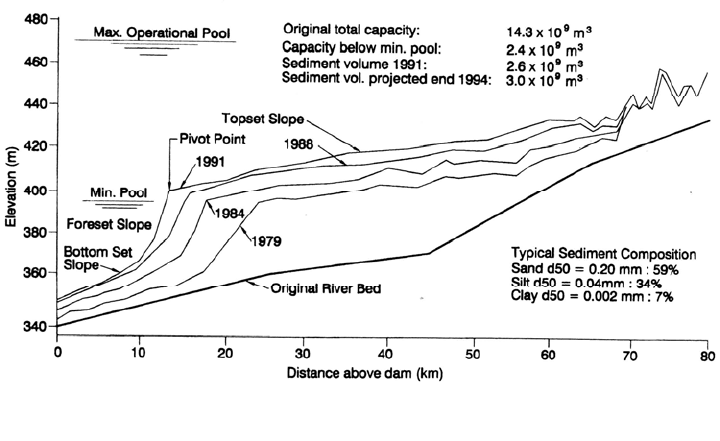
FLUSHING 15.14
and flip buckets, could result in catastrophic erosion and spillway disintegration.
Passing sand through power and irrigation tunnels would create severe erosion,
requiring a continuous and extensive maintenance program.
Sand discharged immediately downstream of the dam would tend to accumulate in
the channel, elevating the tailwater and reducing power production. A continuous
large-scale dredging program may be required.
A bedrock acceleration of 0. 12g (equivalent to a magnitude 5 earthquake at Tarbela)
can liquefy loose saturated deposits similar to those on the foreslope of the Tarbela
delta. The final slope at rest after liquefaction failure would be about s = 0.005. If the
toe of the delta is within 8 km of the dam, the liquefied sediments could reach, enter,
and clog the intakes, putting the irrigation and electrical generation system out of
service for 6 to 12 months.
The inflowing sediment consists of 59 percent fine sand, 34 percent silt, and 7 percent
clay. Approximately 99 percent of the inflowing load is trapped and accumulates,
primarily in the form of a delta deposit which is advancing toward the dam (Fig. 15.9).
Delta topset beds have a slope of about s = 0.0006 to 0.0008. Most sediments are deposit-
FIGURE 15.9 Advancement of delta deposits toward Tarbela Dam, Indus River, Pakista
n
(after Lowe and Fox, 1995).
ed on the topset bed as the reservoir fills and levels rise during the wet season, but when
the reservoir is drawn down for irrigation deliveries, the river reworks and transports
these deposits downstream, extending the delta toward the dam. Most sediment is
transported to the face of the delta at the onset of the wet season when the pool level is
still low and discharge is increasing from 1500 to 4500 m
3
/s.
Several sediment management strategies have been considered. Erosion control in the
watershed, which drains the tectonically active Himalayas, is not technically feasible.
Construction of an upstream dam could temporarily trap sediment, but no such project is
ready for construction. Dredging has been discarded because of the extraordinary volume
of sediment involved, about 150 Mm
3
/yr. A normally-submerged rock embankment or
dike constructed upstream of the intakes, and submerged at normal pool level, can tem-
porarily prevent encroachment of the toe of the delta into the intakes. By gradually rais-
ing the minimum pool elevation, all delta deposition can temporarily be focused into

FLUSHING 15.15
areas more than 8 km above the dam. These last two measures, used together, can delay
serious sediment problems by as much as 40 years. Nevertheless, continued long-term
operation of the project can be realized only by developing a system to pass sediments
beyond the dam.
Under the proposed long-term sediment management strategy, coarse sediment would
be trapped in the upper part of the pool during impounding periods. The deposited
material would be flushed through a high-level bypass channel around the dam at the
beginning of the subsequent flood season by lowering the pool following irrigation
season deliveries. Because this strategy involves temporary sediment storage and
remobilization, it is classified as a flushing technique rather than sediment routing. The
invert elevation of the flushing channel would be set more than 80 m above the original
streambed elevation, and also above the level of the hydropower intakes. This high invert
elevation reflects cost and technical considerations associated with construction of the
large-capacity (4500 m
3
/s) bypass channel. A normally submerged dike would be
constructed around the power intakes, thereby allowing delta deposits to approach the
vicinity of the dam and enter the high-level flushing channel without entering the intakes.
The concrete-lined trapezoidal flushing channel would have a 60 m bottom width and 15
m depth, with its upstream invert about 20 m below the dike crest. This layout is
conceptually presented in Fig. 15.10, which shows the normally submerged semicircular
dike which protects the intakes from bed material and also diverts water and sediment
into the bypass channel when the reservoir is drawn down for flushing. The channel
would discharge sediment during a 20- to 30-day period of low reservoir levels at the
beginning of each wet season, and sediment concentration in the diverted water is
expected to run between 1 and 5 g/L based on field measurements of sediment
concentration in the river as it flowed across the delta deposits. Reservoir volume would
be stabilized at a size significantly smaller than the original capacity. All power pro-
duction would necessarily cease during the flushing period. Because Tarbela is a major
source of electrical energy in Pakistan, an alternative power supply is required to sustain
electrical service during flushing periods.
15.5 EROSION PROCESSES DURING FLUSHING
Flushing releases are characterized by both extreme and highly variable sediment con-
centrations. Channel erosion and slope failures within reservoir deposits dominate during
the flushing process, and sheet erosion of deposited floodplain sediment is insignificant.
15.5.1 Slumping at the Dam
When a bottom outlet is first opened to initiate flushing, and if poorly consolidated fine
sediment have accumulated above the outlet, slope failure can be initiated in the vicinity
of the outlet with slumping and plastic flow of the deposits. This slumping is illustrated in
the photograph at the small Santa María Dam in Guatemala (Fig. 15.11). A similar
pattern has been observed by the first author at small reservoirs in Puerto Rico. At
Hengshan Dam in China, mud on the floodplain surface within 350 m of the dam slid
gradually into the channel and was released through the bottom outlet over a period of
several days (Fan, 1985). At the 20-MW Mangaho River project in New Zealand, 59
percent of the storage capacity had been lost after 45 years and the bottom outlet was
buried under 13 m of silt after 25 years without sluice operation. There was no flow dur-
ing the first day the gate was opened, but on the second day silt began to extrude from the
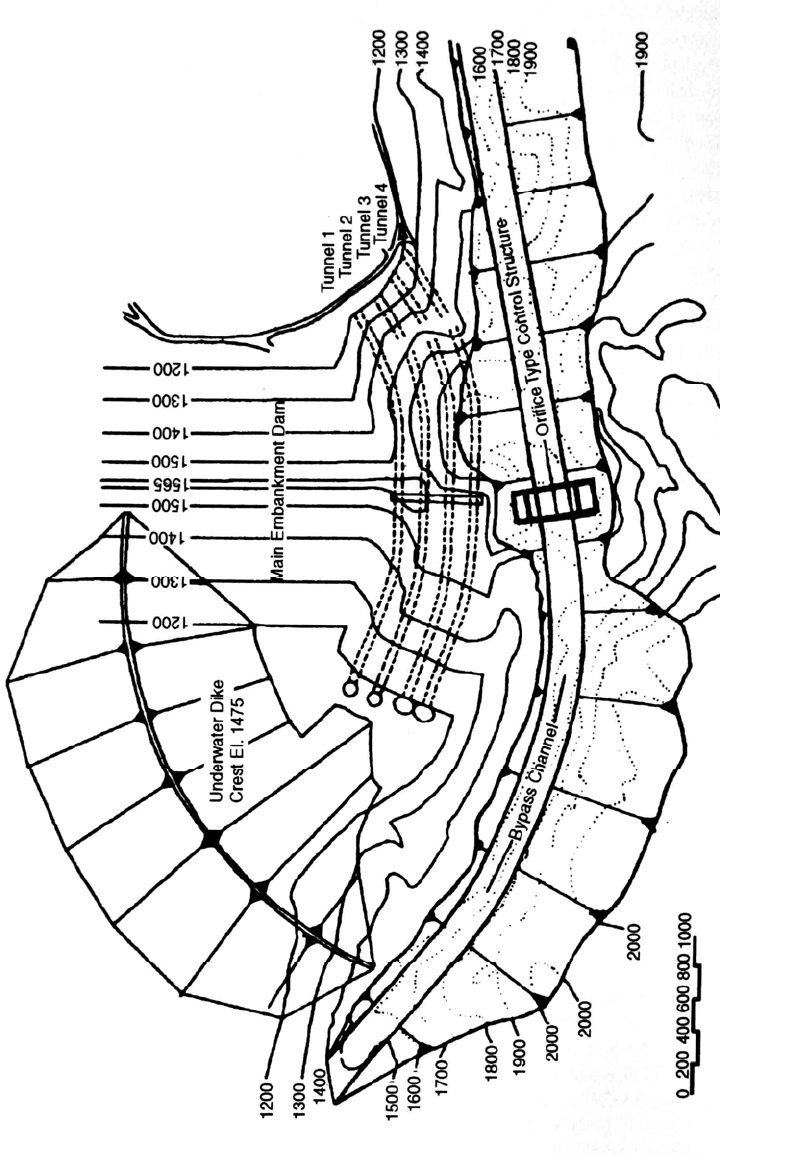
FLUSHING 15.16
FIGURE 15.10 High-level Sediment bypass system proposed at Tarbela Dam (after Lowe and Fox, 1995). The
underwater dike is used to allow delta deposits to reach the high-level bypass channel, without entering the powe
r
intakes. Elevations and distances in feet.
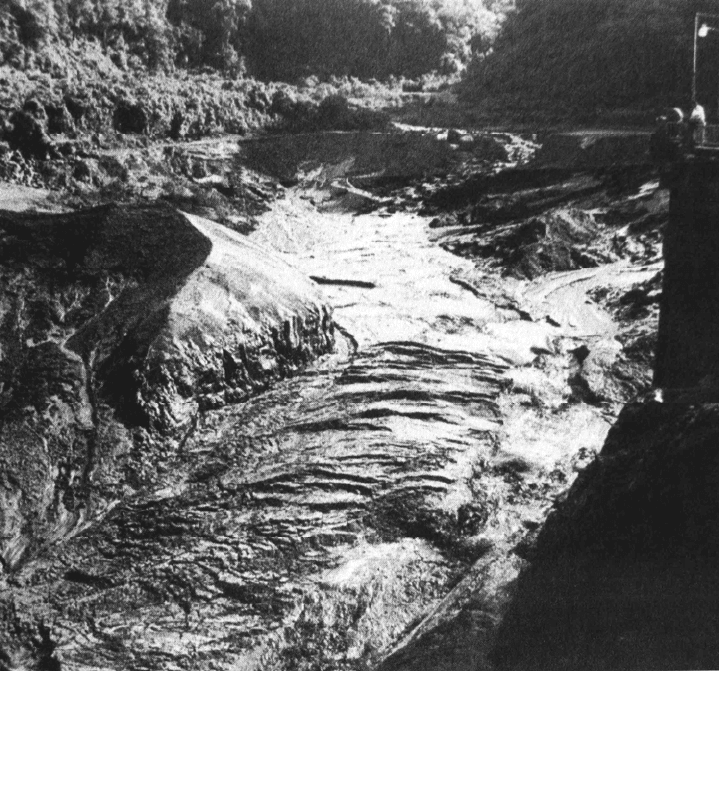
FLUSHING 15.17
FIGURE 15.11 Slumping of fine-grained deposits near the dam in the small 285,000 m
3
Santa
Maria reservoir on Río Samala, Guatemala, as sediment is discharged through bottom outlets.
Sediment slumping was accelerated and removal enhanced by closing gates to temporarily
inundate the deposits, then draining the reservoir a second time (V. Galay).
bottom outlet, emptying the reservoir and leaving a crater-like depression above the
sluice entrance. About 75 percent of the accumulated sediment was flushed during the
subsequent month. During this period it was necessary to haul out logs and tree stumps
that blocked the sluice entrance. Thereafter flushing was undertaken annually (Jowett,
1984).
15.5.2 Slope Failure
The erosion of flushing channels produces unstable banks which will slump or slide into
the channel, and bank failure is the primary mechanism involved in the widening of
flushing channels. The main flushing channel may deepen until it encounters the armored
bed of the preimpoundment river, after which further erosion can occur only by widening
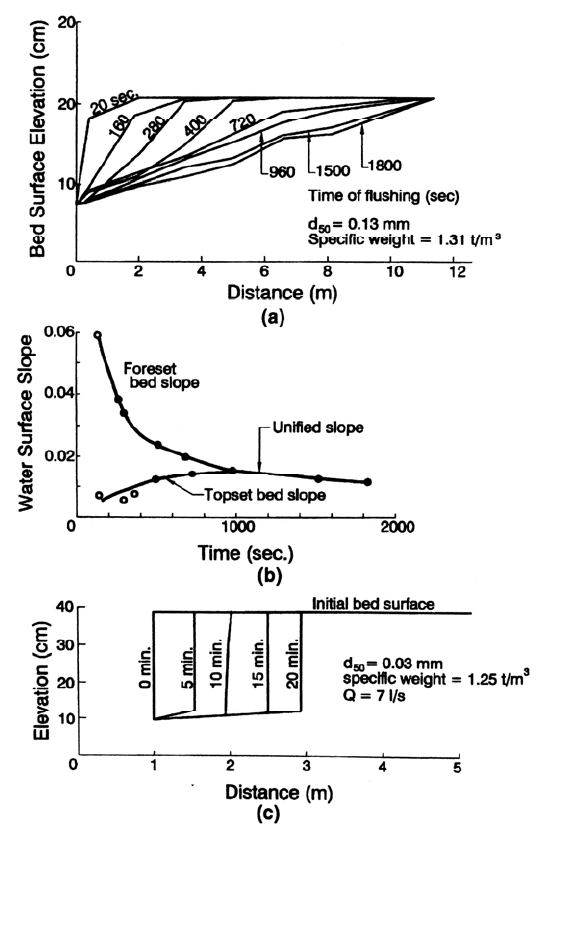
FLUSHING 15.18
of the channel by bank failure. The type of slope failure and the stable angle of repose
will depend on the sediment characteristics. Examples of several forms of bank slides
observed during flushing at Sefid-Rud are illustrated in Figs. 23.19, 23.21, and 23.22.
15.5.3 Retrogressive Erosion
A channel erosion process characterized by a zone of high slope and rapid erosion, mov-
ing upstream along a channel having a lower slope and erosion rate, is termed retro-
gressive erosion. This process is illustrated in Fig. 15.12a, based on observations in a
laboratory flume, and in Fig. 24.14 as observed in Sanmenxia Reservoir. The highest rate
of erosion occurs along the steep drop at the downstream end of the deposit, causing this
area of maximum erosion to move upstream through a headcutting process similar to
gully erosion. The point of slope change or headcut may be visually apparent as shown in
FIGURE 15.12 Characteristics of retrogressive erosion from flume tests. (a)
Longitudinal profile in unconsolidated deposits. (b) Transition toward a unifie
d
slope over time, corresponding to flume test shown in a. (c) Longitudinal
profile in consolidated sediments.

FLUSHING 15.19
Figs. 23.20 and 25.13. The point of slope change is also called the pivot point or the
nickpoint, and the term nickpoint erosion is also used to describe retrogressive erosion.
Multiple headcuts can be formed along the length of an eroding channel.
Retrogressive erosion is the principal method for the formation of flushing channels
through reservoir deposits. The opening of deep outlets – which establishes flow across
deposits having a relatively mild slope, with an abrupt drop or even a waterfall at the
downstream end – initiates retrogressive erosion, creating a nickpoint that can move
upstream rapidly depending on the nature of the deposits and the erosional forces. At
Sanmenxia Reservoir on the Yellow River, a reach extending 80 km upstream from the
dam was affected by retrogressive erosion between October and November 1964, the
longest such phenomenon recorded in a reservoir (Fig. 24.14). In contrast, retrogressive
erosion lasts less than 24 hours in erodible silt deposits in smaller reservoirs in China
such as the 2-km-long Hengshan Reservoir. In more consolidated deposits, retrogressive
erosion will move upstream more slowly. Erosion moved upstream at the rate of 100
m/day in cohesive sediments at Sefid-Rud Reservoir (Tolouie, 1993).
Retrogressive erosion results from the change in hydraulic energy caused by the
discontinuous longitudinal profile, and it is not dependent on any specific grain size in
the deposit, although erosional patterns are influenced by the deposit characteristics.
Retrogressive erosion can occur in coarse sediments on a river delta (Randle and Lyons,
1995) and also in fine-grained and cohesive sediments. In noncohesive or unconsolidated
cohesive sediments retrogressive erosion tends to proceed upstream as shown in Fig.
15.12a. In consolidated deposits the eroding face tends to be more nearly vertical as in
Figure 15.12c. The creation of a stepped erosion face created by alternating layers of
cohesive and noncohesive sediment was observed at Sefid-Rud Reservoir (Fig. 23.14).
As retrogressive erosion proceeds there is a gradual transition of the foreset and topset
slopes to a unified slope, as shown in Fig. 15.12b. The most intense erosion occurs in the
area of highest slope and the pivot point (or nickpoint) continuously moves upstream,
causing the foreset slope to decrease. At the same time channel erosion causes the topset
slope to increase, until a unified slope is achieved. At this point retrogressive erosion has
ended and the erosion process may now be termed progressive erosion. Jiang (1992)
reports that sediment transport computations based on unit stream power have been used
to predict rates of retrogressive erosion.
15.5.4 Progressive Erosion
The term progressive erosion refers to a channel erosion process which occurs uniformly
or progressively along the length of a channel instead of being concentrated at the down-
stream end. In general, when the suspended-sediment concentration in flowing water is
less than the sediment carrying capacity, the flow will entrain sediment from the channel
bed. When clear water enters a zone of erodible deposits having uniform slope and grain
size, it will progressively entrain sediment by eroding the deposit. The rate of bed erosion
will initially be rapid because of the large available sediment-carrying capacity of clear
water. As the flow progresses downstream and entrains sediment, its capacity to erode
and transport additional sediment will decrease, eventually reaching zero. In this manner
progressive erosion can cause a high rate of bed erosion at the upstream end of a deposit
and less erosion at the downstream end. This erosion pattern can be offset in reservoirs by
the tendency for deposits to be coarser and less erodible at the upstream end.
15.6 VARIATION IN EROSION RATE AND SEDIMENT RELEASE
The rate of channel erosion may be limited by either the erosive hydraulic forces or the
available sediment supply in the channel, and in the riverine environment the discharge of
FLUSHING 15.20
sediment of different grain sizes may be characterized as either transport-limited or
supply-limited. The wash load is typically supply-limited, since the load of fine sediment
is almost always limited by the rate of supply from the watershed rather than hydraulic
transport capacity. Conversely, the load of coarse bed material is transport-limited, since
hydraulic transport capacity rather than sediment abundance is the limiting factor. The
same concept applies to the rate of sediment release during the flushing process and can
be used to explain variations in the concentration and grain size of sediment release
during flushing events.
15.6.1 Within-Event Variability
Flushing events are characterized by large changes in the rate of channel erosion and the
suspended-solids concentration in the flow exiting the dam, as illustrated in Figs. 15.5,
19.18, 21.6, 23.15, and 25.8. These variations primarily reflect changes in the availability
and erodibility of fine sediment during the flushing event.
Channel formation and channel maintenance tend to produce two distinct patterns of
sediment release. Material deposited in previous years or decades is continuously scoured
during channel formation, producing sediment concentrations which are initially high and
decline gradually (Fig. 15.5). The maximum concentration and rate of sediment release is
limited by the erodibility of the deposit, which has become consolidated over time.
Concentration variations will occur over the course of a flushing period because of
changing inflow rate and variations in the rate of sideslope failures along the flushing
channel.
During maintenance, flushing the channel will contain only recently deposited mate-
rials which are readily mobilized, including recently reworked sediment. The transition
from drawdown to riverine flow during a maintenance flushing event is characterized by
a dramatic increase in the sediment concentration discharged from the dam as the
unconsolidated fines in the submerged channel near the dam are rapidly evacuated, gen-
erating short-term sediment concentrations of hundreds of grams per liter. However, as
the readily eroded material is washed out, the concentration of fines becomes supply-
limited, depending on the rate of bank erosion and collapse. In contrast, the discharge of
coarse material (e.g., sands) may be transport-limited throughout the flushing event and
may be much more uniform over time. Thus, during a maintenance flushing event, the
release of fine sediment may be initially transport-limited and subsequently supply-
limited, and will typically exhibit extreme variations in concentration and rate of release.
In contrast, the discharge of coarse bed material (including sediment eroded from delta
deposits) may be transport-limited throughout the event and experience much smaller
variations in concentration and rate of release. As a result, in a reservoir having a
significant load of both fine and coarse sediment, short flushing periods may be effective
in removing fines but longer flushing periods and larger flushing flows will be required to
remove the inflowing load of coarse material.
15.6.2 Between-Event Variability
During channel formation the discharged sediment is derived from the erosion of older
and more consolidated deposits. Sediment concentrations remain high during the entire
flushing event as the flow continuously erodes deposits. In contrast, maintenance flushing
erodes the recently deposited and poorly consolidated fines from the channel, producing a
short period of extreme sediment concentration including hyperconcentrated flow, until
the channel sediment supply is exhausted. These contrasting mechanisms can cause wide
between-event variations in sediment concentration. Peak concentrations in channel
maintenance events at Sefid-Rud were almost double the concentrations during channel
formation events (Table 15.2). Variation in the delivery of fines to the reservoir also

FLUSHING 15.21
causes sediment discharge to be highly variable between events, as illustrated by the high
variability between maintenance flushing events at Cachí Reservoir, also shown in Table
15.2. The high load evacuated in 1988 at Cachí reflects increased sediment input from
flooding and a landslide (Jansson, 1992a). The high variability at Sefid-Rud and Cachí
have occurred even though both sites been operated in a consistent manner over the
period covered by the data, subject to normal operational variations caused by natural
events such as floods. These data illustrate the difficulty of accurately predicting
sediment release during flushing.
TABLE 15.2 Variation in Sediment Discha ge and Concentration During Flushing r
Cachí Sefid-Rud
Year
Peak
Concentration,
g/L
Sediment
Removal
10
6
t
Peak
Concentration
g/L
Sediment
Removal
10
6
t
1981 0.477 170* 24
1982 0.386 180* 12
1983 0.545 145* 52
1984 0.665 195 68
1985 344 142
1986 330 46
1987 292 27
1988 430 1.266 305 57
1989 170 0.482 398 54
1990 280 0.653 284 32
*Channel formation stage. All other events are maintenance flushing.
Source: Sefid-Rud data from Tolouie (1993); Cachf data from Ramirez and Rodriguez (1992).
Data from 38 flushing events with full drawdown at the Zemo-Afchar hydropower
station located downstream of the Kura and Aragvi Rivers in the former Soviet Union
were reported by Gvelessiani and Shimaltsel (1968) and again reflect a high degree of
variability. During the first 2 years of operation the reservoir lost 44 percent of its
capacity, another 32 percent was lost in the next 8 years, and 4 percent was lost in the
next 18 years (1937 to 1954). Prior to 1939 the reservoir had been operated with limited
drawdown for flushing, but this was not effective. From 1939 through 1966 a total of 38
flushing events were conducted with full drawdown, for which data from 36 were
reported. Flushing frequency varied from once to as many as four times a year. The rela-
tionship between mean suspended sediment concentration and mean discharge below the
dam (Fig. 15.13) shows that larger discharges tended to remove more sediment, yet
produced lower mean sediment concentrations. The highest mean sediment concentra-
tions were associated with the shortest flushing duration because the highest solids con-
centration occurs at the beginning of the event and then declines. There is a wide range of
variability from one event to another because of factors including flushing duration and
sediment accumulation between flushing events. Peak discharge concentrations, reported
for only two events, were 270 and 370 g/L.
15.6.3 Effect of Discharge on Erosion Rate
Guo and Li (1984) analyzed flushing at the Hengshan Reservoir in China and noted that
lower (base flow) discharges tended to cut a narrow deep channel, but a wider channel
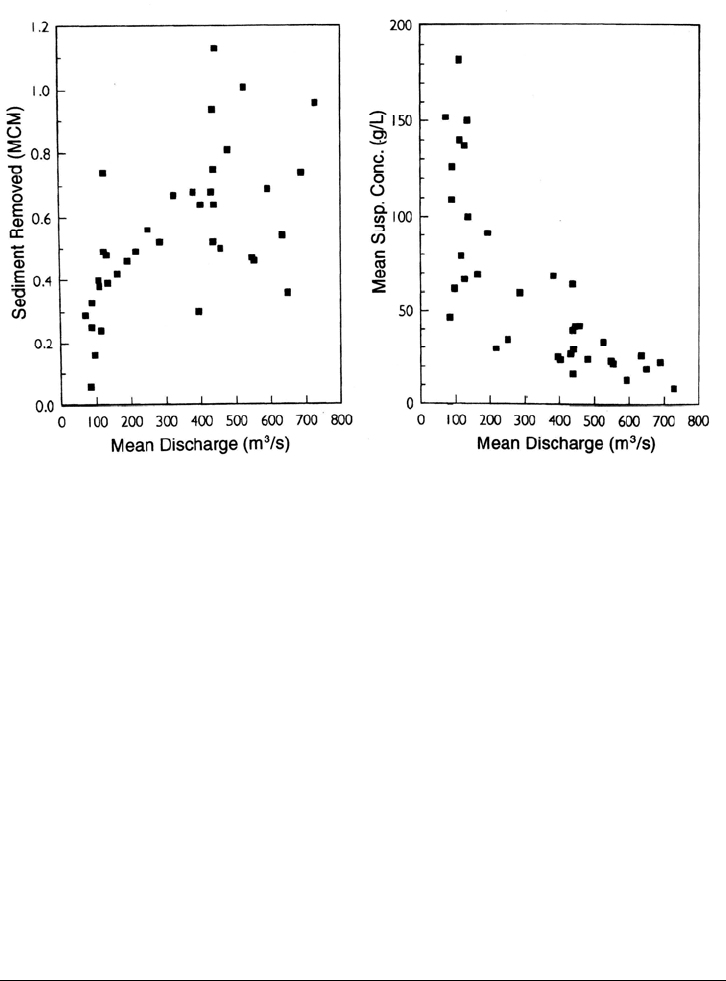
FLUSHING 15.22
FIGURE 15.13 Flushing discharge relationships for 36 flushing events at Zemo-Afcha
r
reservoir in the former Soviet Union (data from Gvelessiani and Shimaltsel, 1968). Mean
discharge refers to the duration of the flushing event. MCM = 106m3.
can be produced with a larger flow. Actually, the channel may be deepened by using
either smaller or larger flows, but widening is achieved by large flows only. In China it
was found that the flushing effect is maximized if a reservoir is emptied immediately
prior to the arrival of floods so that the flood flow can exert its erosive force on deposits
which have not yet had the opportunity to fully dewater and consolidate after emptying
the reservoir. The phrase used to describe this strategy is "Deepen by small flow, widen
by flood flow." That larger flows widen flushing channels has also been observed in
sediments with a high clay content (Tolouie, 1993) and in coarse noncohesive delta
deposits (Randle and Lyons, 1995). On the basis of work in Algeria, Duquennois (1956)
described the use of a small storage dam upstream of a reservoir to temporarily store and
then rapidly release water, converting a continuous inflow into a series of larger pulsed
flows. The pulsed flow scoured delta deposits and created turbid density currents to
transport sediment closer to the dam.
15.7 FLUSHING EFFICIENCY
5.1.1. 15.7.1 Definition
The term flushing efficiency (F
e
) is defined as the ratio of deposit volume eroded to the
water volume used during flushing over any specified time interval. For inflow and out-
flow water volumes V
i
and V
o
(m
3
),
inflow and outflow total sediment concentrations C
1
and C
o
(kg/m
3
), and deposit bulk density ρ (kg/m
3
), flushing efficiency F
e
may be com-
puted by:

FLUSHING 15.23
F
e
(V
0
C
0
V
i
C
i
)
/
V
0
(15.1)
During empty flushing when V
0
and V
i
, and if C
i
and ρ are constant, flushing efficiency is
directly related to C
o
, the total solids concentration in the discharge. An alternative
expression for flushing efficiency is the water: sediment ratio
(Qian, 1982), which is the
inverse of flushing efficiency (1/F
e
).
15.7.2 Flushing Efficiency with Partial Drawdown
Reservoir drawdown during flushing may be limited by operational requirements, or by
the elevation of the available outlets if no bottom outlets are provided. When flushing
flow is discharged through outlets located significantly above the level of the deposits,
resulting in a pool of impounded water before the dam, the flushing efficiency is typically
very low. Flushing efficiencies for several reservoirs where sediment was released
through high-level outlets are summarized in Table 15.3. Flushing under conditions of
partial drawdown may erode upstream sediments and redeposit them closer to the dam,
and, if a low-level outlet is opened, some of the eroded sediment may be vented as a
turbidity current, but this is an inefficient means of removing sediment from a reservoir.
Effective sediment removal through a high-level outlet can be achieved only after the bed
of the deposits has risen close to the level of the outlet, as described at Tarbela Dam in
Sec. 15.4.2.
Flushing with partial drawdown may be useful under specific circumstances. For
example, drawdown and sediment release through a high-level outlet was undertaken at
the Guernsey Reservoir in Wyoming to deliver fine sediment to a downstream unlined
irrigation canal. The sediment partially sealed the canal bottom and reduced canal seep-
age losses. Although sediments were scoured from the upper portion of the reservoir
during the 1961, 1962, and 1963 drawdowns, the suspended solids concentration in water
discharged from the reservoir never exceeded 0.8 g/L (Jarecki and Murphy, 1963). The
principal effect of these and subsequent drawdowns has not been to release sediment, but
TABLE 15.3 Overflow Drawdown Flushing
Reservoir
Outflow
situation
Years of
operation
Discharge,
m3/s
Duration
Flushing
efficiency
Water:sediment
ratio
Guernsey,
U.S.A.
Overflow
spillway
1960-1962 56.6 - 198
10-18
days
0.00017 5880
Warsak,
Pakistan
Overflow
spillway
1976-1979,
5 flushings
1410
Total
490.5 h
0.00169 592
Liujiaxia,
China
Overflow
and outlets;
water level
lowered =
4.4-7.8 m
1981,1984,
1985,1988
1660 -
2090
103 -
177 h
0.0023 -
0.0071
435-141
Shuicaozi
China
Overflow
spillway
1965,1966,
1974, 1978,
1980, 1981
21.4-230 3-4 days 0.012 -
0.043
83-23
Source: Fan (1995).
